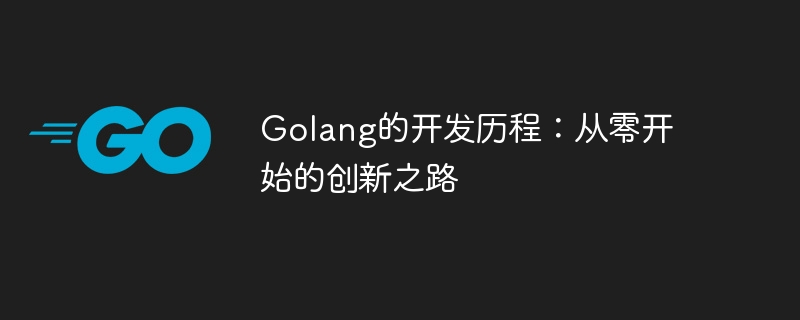Home >Backend Development >Golang >Golang's development history: the road to innovation from scratch
Golang's development history: the road to innovation from scratch
- WBOYWBOYWBOYWBOYWBOYWBOYWBOYWBOYWBOYWBOYWBOYWBOYWBOriginal
- 2024-03-07 10:09:041095browse

The development history of Golang: the road of innovation from scratch
In today's fast-paced software development field, new programming languages are emerging one after another, among which Golang is one of the A revolutionary programming language favored by developers. It is simple, efficient, and has strong concurrency performance, allowing developers to build reliable software systems faster. This article will lead readers to explore the development process of Golang from scratch, and let everyone better understand this exciting programming language through specific code examples and experience sharing.
1. Getting Started with Golang
Golang’s official website provides a wealth of learning resources and documentation, which is very suitable for beginners to get started. First, we need to install the Golang development environment. You can go to the official website to download the corresponding version of the installation package, or install it through the package management tool. After the installation is complete, we can use a simple Hello World program to verify whether the environment is successfully built:
package main
import "fmt"
func main() {
fmt.Println("Hello, Golang!")
}Save the above code as a hello.go file and run it through the command line tool go run hello.go, you can see that the output result is Hello, Golang!, which marks that we have successfully started our Golang journey.
2. Golang’s syntax features
Golang’s syntax is concise and clear, with rich features. The following will introduce several commonly used syntax features, and attach corresponding code examples.
Variable declaration and assignment
Golang’s variable declaration format is var variable name variable type, the example is as follows:
var name string name = "Alice"
You can also use simplified writing:
age := 30
Control process
Golang supports common control process statements, such as if-else, for loop, etc. Examples are as follows:
if age >= 18 {
fmt.Println("成年人")
} else {
fmt.Println("未成年人")
}
for i := 0; i < 5; i++ {
fmt.Println(i)
}Function definition
Golang's function definition format is func function name (parameter list) return value type {function body}, the example is as follows:
func add(a, b int) int {
return a + b
}3. Concurrent programming in Golang
Golang It inherently supports concurrent programming, and concurrent operations can be easily implemented through goroutine and channels. Below we will demonstrate the usage of goroutine through a simple example:
package main
import (
"fmt"
"time"
)
func main() {
ch := make(chan string)
go handleMessage(ch)
ch <- "Hello"
time.Sleep(1 * time.Second)
}
func handleMessage(ch chan string) {
msg := <-ch
fmt.Println("Received message:", msg)
}In the above example, we created a message processing function handleMessage through goroutine and delivered the message through the channel. After sending a message to the channel, the main program waits for the execution result of the goroutine by sleeping for 1 second.
4. Innovative Case: Using Golang to Develop Web Applications
In addition to basic syntax features and concurrent programming, Golang is also widely used in the field of Web development. Below we use a simple web application example to demonstrate the application of Golang in web development:
package main
import (
"fmt"
"net/http"
)
func handler(w http.ResponseWriter, r *http.Request) {
fmt.Fprintf(w, "Hello, Web!")
}
func main() {
http.HandleFunc("/", handler)
http.ListenAndServe(":8080", nil)
}The above code creates a simple HTTP server and returns a simple text response when a request is initiated. We can check the effect by visiting http://localhost:8080.
Conclusion
Through the explanation and sample code of this article, I believe that readers have a certain understanding of Golang. As a powerful programming language, Golang has concise syntax and efficient concurrency performance, and is very suitable for building various software systems. I hope this article can help readers better master Golang development skills and start their own innovation path.
The above is the detailed content of Golang's development history: the road to innovation from scratch. For more information, please follow other related articles on the PHP Chinese website!

